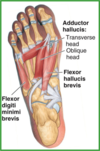Lecture 30 in class (17-7-14) Flashcards
What are the bones of the ankle and foot
- 14 phalanges
- proximal phalanges
- middle phalanged
- distal phalanges
- 5 metatarsals
- 7 tarsals
- talus
- calcaneus
- cuboid
- navicular
- cuneiforms

What is the fascica of the ankle?
- superior and inferir extensor retinacula- anterior leg tendons
- **superior and inferoir fibular retinaculua- **lateral leg tendon (evertors)
- felxor retinaculum- deep postierior leg tendon (flexors)
What is in the tarsal tunnel?
- Tom tibialis posterior m.
- Dick felxor digitorum longus
- Bloody tibialis posterior a.
- Nervous tibial n.
-
Harry flexor hallicus longus
*

What is tarsal tunnel syndrome?
when the tibial nerve gets entraped
What is the cutaneous innervation of the dorsal foot?

- saphenous
- deep fibular
- superfical fibular
- sural n.
What is the cutaneous innervation of the platar side of the foot?

- saphenous
- medial plantar
- lateral plantar
- tibial
- .sural
What is the innervation of hte foot?
Dorsal foot
- superfical fibular
- deep fibular - anterior leg of foot and all muscles of dorsum of foot
Medial Plantar (L.A.F.F)
- 1st Lumbricle
- Abductor halicus
- flexor hallluics brevis
- flexor digitorum brevis m.
Lateral plantar
all the rest of the muscles
Babinski sign
deep tendon reflex
flexion of toes is normal response after 4 years old
abdnormal= spreading of toes (this is normal under the age of 4)
What are the arteies of the foot?
from anterior al tibial
- dorsalis pedius a
- sole of foot deep plantar
- across metatarsals 2-5 arcuate a
sole of foot
from posterial tibial a
- medial plantar a
-
deep plantar arch latearal plantar
- joined by deep plantar a from dorsum of foot

dorsum foot muscles
**extensor digigtorum brevis **calcaneous–> extensory expansion (2-4)
**extensor halicous brevis **calcanous–> proximal phalenex
extend toes/ big toe
deep fibular nerve
plantar aponeourissi
- protects the sole of the foot
- supports longitudinal arches
- attaches proximal phalex–> calcaneous
- has 5 bands that attach to digits

what is plantar fasciitis
- most common hindfoot problem in runners
- straning and inflammation of plantar aponeurosisi
- hurts to walk after sleeping all night
- can be acute or chronic
*
What are the muslces in the first layer of the foot?
- abuctor hallicus
- flexor digitorum brevis
- abductor digitiminimi
- What is the muscle on the far right?
- What is its insertion/ orgin
- What is ins innervation?
- What is its action?

- abuctor hallicus
- calcaneous–> prox phalanx
- medial plantar n
- abducts and flexes big toe at MP
1st layer
- What is the muscle in the middle?
- What is its insertion/ orgin?
- What is ins innervation?
- What is its action?

- flexor digitorum brevis
- calcaneous–> either side middle phalenx 2-5
- medial plantar
- flex toes 2-5 at pip
- 1st layer









